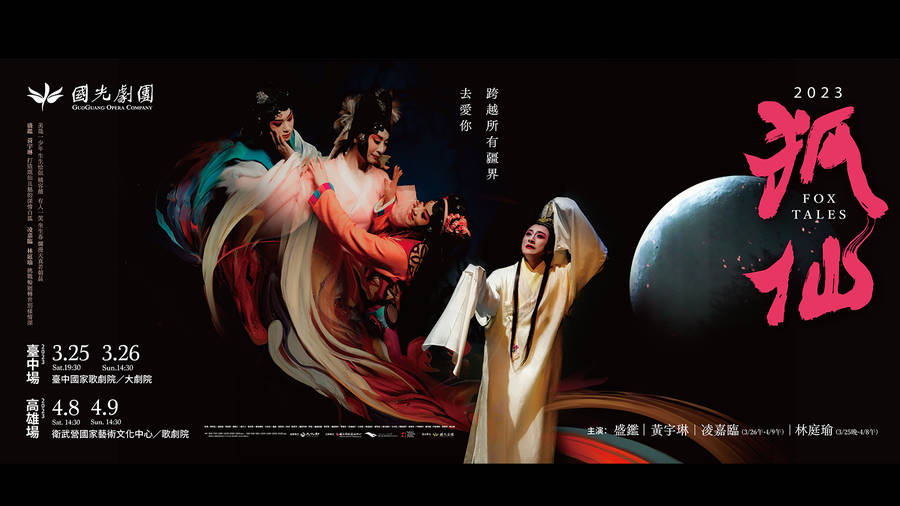Blog
A Rough Ride to the Perfect Ending

Photo©劉振祥
by CHAO Hsueh-chun
Fox Tales made history at its 2009 debut as the most romantic, fantastical contemporary Peking opera from Taiwan. With the story's structural flexibility, today's production team decided to retell it with the enhancement of 4Dviews and multimedia. Originally, it was to show at the Taiwan Traditional Theatre Center in Taipei and the National Taichung Theater, but with all the uncertainty over the past couple of years with Covid, the latter was canceled, making way for showings at Weiwuying!
The plot is quite complex as the unexpected occurs within the conventional process of reincarnation. A forest-dwelling white fox can change its gender at will. In its next life, as a gentleman from a decent family, he falls in love with a woman named Fengsanniang, but having been hurt in a previous relationship, he breaks off his relationship with her, though with great reluctance. That seems to be the end of their chances of happiness together, but in the next life, he comes back as a woman named Ching-ching and re-encounters Fengsanniang (who is now Ye-na) at a Lantern Festival event. Their lives, both present and past, become intertwined, and the whole thing is a ride of ups and downs that finally ends happily.
SHENG Jian plays the gentleman, which is no easy task. He (and his female counterpart, Ching-ching) is a product of the anime culture's transcendence of gender boundaries, so the character alone is quite interesting. As for the stage persona, this male character is unprecedented when it comes to contemporary Peking opera scripts, as he plays the laosheng (elderly scholar) but integrates the established gestures of a dan (female role). The established gestures of traditional opera are part of a formula for portraying roles: the actor must have a firm grasp on these gestures to ensure the character will be properly played. In Fox Tales, the gestures for male and female roles, which are meant to emphasize the features of each character type, are purposely mixed and surprisingly produce the perfect amalgamation of one who is both male and female, transcending the boundaries of gender. One could say that without these established gestures, the stage persona of this male character would fail to materialize, in which case the whole piece would cease to exist. Viewers interested in this adaptation of the gestures to surpass the gender boundaries of the characters might like to watch SHENG in One Hundred Years on Stage, in which he plays the dan role of Xiaoyunxian, who also has aspects both male and female (though the portrayal is quite different than that of the gentleman). This is part of the precious legacy of traditional opera's rich form of expression that has been passed on to contemporary theater. There is unlimited potential for how established gestures can contribute to creating characters of all sorts from contemporary culture.
Just as SHENG's character is a male with feminine characteristics coming through at times, a bit of masculinity sometimes issues forth from HUANG Yu-lin's (female) Ching-ching. Though the latter's transcendence of gender lines is not as obvious as the former's, you get remarkable glimpses that create a lasting impression. It may be compared to such female characters as Zhu Yingtai from The Butterfly Lovers, who disguises herself as a boy in order to go to school. Though Zhu dresses as a boy, she must frequently remind the audience of her true gender. In our case, though, Ching-ching purposely creates uncertainty as to her gender whenever she is reminiscing about her love for Fengsanniang in her past (male) life.
Though the art form of Peking opera is an old one, Fox Tales is contemporary in several ways, so it is only natural that contemporary technology, ranging from simple projection to the highly technical 4Dviews, has been integrated. Only time will tell which of these new additions will stick with the art form. The 2009 production of the piece was filled with features of our times in the plot, the characters' feelings, and their stage persona as dictated by the use of established gestures. And now, on top of that foundation, the 2023 production goes further in exploring even newer potential.
You May Also Like
Spiraling Unchecked to See Her Lover Once Again: Legend Lin Dance Theatre's The Eternal Tides
Seeing LIN Lee-chen's dance is like watching an action film in super slow-mo. 4K resolution at 120 frames per second flows by silently, and each frame is perfectly refined and beautiful.

A Beautiful Romance or the Fickleness of Love? Eugene Onegin, Inside and Out
While searching for inspiration for an opera in the spring of 1877, TCHAIKOVSKY was told by a friend to adapt one from Eugene Onegin, a novel in verse by the great Russian author Alexander PUSHKIN.



